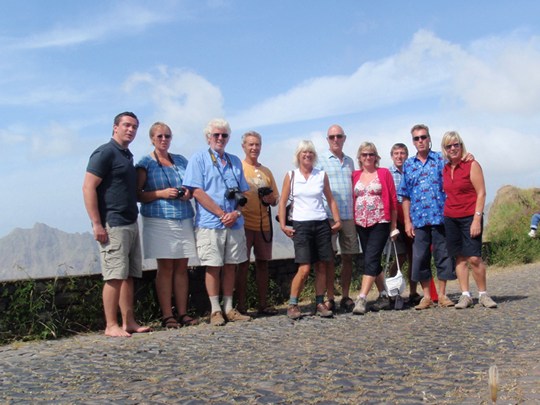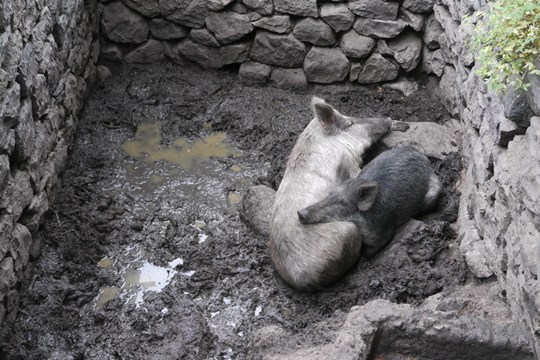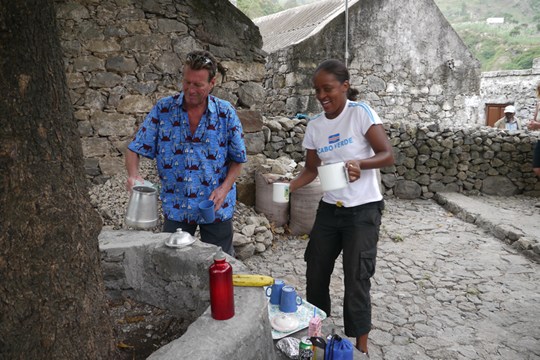Date:
28 November 2009
For those in search of Paradise –
look no further. The archipelago nation of Cape
Verde consists of ten volcanic islands in the
shape of a horse shoe about 170 miles across. Located 450 miles west of
Africa in the middle of the
Atlantic, the uninhabited islands were discovered in
1462, and settled by the Portuguese who controlled the islands until
independence in 1975. The inhabitants are of mixed race origin from the black
Africans who were brought here as slaves, either to work the land here or in
transit to the Caribbean, and the Portuguese settlers. In
colour, looks, height and temperament they are totally different from the
Senegalese. Unlike the pushy, over-familiar, generally insincere “you are my
best friend” approach of the Senegalese (as a prelude to trying to sell
something you don’t want, or to rip you off), the
Cape
Verdeans generally ignore the few
visitors who come to the island. It is not that they are unfriendly, it is
simply that they are very reserved. When introduced to you by a local, they
slowly thaw and it is then that you see the beaming smile, the contentment and
the warmth of these delightful people.
The inhabitants of the islands total only 400,00 but
there are a further 600,000 CapeVerdeans who have left the islands for Europe
and America. However, many are now realising that the lure of money in
distant lands has deprived them of the contented lifestyle in their beautiful
country and this trend is now reversing.
The official language of the islands is Portuguese but
most of the population speak the local dialect of Krioule. Whilst all the
islands are volcanic (Fogo still has an active crater) they are all different in
terms of terrain and rainfall and the isolation of each individual island means
that the Krioule dialect also differs from island to island.
Surrounded by the ocean, the temperature is less hot than
Africa and it varies little during the year, ranging from
a pleasant 25 - 29 degrees C. The one problem that some of the islands have is
lack of water. But whilst Sao
Vicente (where the marina is) has so little rainfall that
it is officially a desert and relies on desalination for its expensive water,
San Antao just 15 miles northwest has much more rainfall and springs which flow
year round.
The one thing which unites all
Cape
Verdeans is their rich musical
culture. Their music has links to the mournful Portuguese Fado but is also
strongly influenced by African, Caribbean and Brazilian
music as well. Most bars and restaurants in Sao
Vicente’s capital of Mindelo reverberate nightly to the
sound of music being played by anything from a single artist to a band of eight
or more musicians. In the Club Nautico on the waterfront, the resident artist
plays a right handed guitar left-handed and his party piece is to play some of
his numbers with his teeth! The international musical star of Cape Verde is
Cesaria Evora. Get her CD's!
Before we arrived we were all in trepidation at the news
that there was an epidemic of Dengue fever (http://en.wikipedia.org/wiki/Dengue_fever) in
the islands and we would have to spend our time here in long sleeves, long
trousers and socks to minimise the possibility of being bitten by Dengue
carrying mosquitos. In the event it transpired that whilst there was some Dengue
reported in the southern islands it was on the wain, and there were no incidents
in the northern islands where we were. Indeed it would take a very determined
mosquito to hang on long enough to bite anyone in the strong trade winds which
blow here day and night. In fact, having rigged ourselves out with voluminous
mosquito nets, taken expensive anti-malarial drugs and loaded the boat with
gallons of Deet, we have not seen one mosquito down the entire coast of
Africa – not even in the delta.
But mosquitoes are not the only source of danger. One
rally member broke her ankle badly a couple of days ago and has flown back to
Switzerland to have it operated on, whilst another member broke his leg
horrifically, simply slipping down a ramp in the marina. He has flown back to
France for an
operation. So everyone is creeping around mindful of how the adventure of a
lifetime can turn to dust with just one slip. And there has been a bout of
stomach bugs going round the fleet. The latest victim is Neil who took to his
bed this morning just as we were starting the big spring-clean ahead of the
arrival of Venetia and Peter on Monday. But whilst the bug normally lasts three
days, Neil had a miraculous recovery this evening just after I had finished
cleaning the inside of the boat from top to bottom, and just as the music
started to thump out from the concert the marina are putting on for us this
evening. Neil is now down below getting into his party gear.
The friendly xenophobic banter between the French and the
English continues. Patrick the garrulous Frenchman who runs the rally was asking
Phil from “Minnie B” what
names the British had for the French apart from “Frog”.
Phil told me later that encapsulating the meaning in French of “Cheese-eating
Surrender Monkeys” was quite challenging. I wish I had known about this
conversation before I introduced Neil, my latest crew member, to Patrick
describing Patrick as “Le Grand Fromage”. Given his very recent conversation
with Phil, and that Patrick is a fine figure of a man (c 25 stone), the thin
lipped response suggested that the soubriquet may have been misunderstood. I had to back-pedal furiously explaining
in my best broken French that “The Big Cheese” in English simply meant the Top
Man and was one of the highest compliments one could possibly bestow on a Leader
of the Universe. This did the trick and we left Patrick beaming with pride. The
entente was cordiale once more.
A couple of days ago we went to the
island of San
Antao with the English-speaking members of the
rally. I’m running out of time (as ever) so I am taking the unusual step of
simply copying from the blog of Phil & Norma on “Minnie B” who have
perfectly described the trip. My thanks to them, and if you want to read a
properly written blog their website is www.minnieb.me.uk .
They write “Words do not do justice to the
amazing visit to Sao Antao. We had been told it was superb, but it was an SEE
rating – that’s substantially exceeds expectations, and it doesn’t get better
than that.
So what was it? Well, the island is a short ferry ride (one
hour) from Mindelo and the intrepid group under the leadership of Marta (African
Seawing) was up at dawn on Tuesday to catch the 0800 ferry. The company (some
say bad company) comprised Marta and Frank, David and Suzanne (Suzie Too), Andy
and Sue (Spruce), and Tim and Neal (Mina 2) – all with varying amounts of
luggage for our two nights on Sao Antao. It seemed that we had enough for a
week, whereas we were unsure what kind of odours Tim and Neal would be giving
off as they had so little baggage.
We were
met by our guide, Sonya, and a bus for twice the number of people. Porto Nova,
where we landed is not up to much and the southern side of the island is quite
barren, albeit the main scenic feature is the vast number of new houses
springing up. The approach to building is get some money and get started – this
means there are lots of part-built houses that are grey because the breeze
blocks and cement have not been plastered and painted. When they do get enough
money to paint then the colours are vivid greens, blues, reds and
yellows.
Our bus straightaway climbed the
cobbled road towards the ridge that splits the island in two, and what a treat –
there were forests, gorges, ravines and the near-perfect volcano caldera into
which we walked. The views were spectacular. Some of the houses now changed too
and were of stone walls, with roofs thatched in banana leaf and sisal. The land
became more cultivated and we had our first views of the extensive planting of
sugar cane (more about this later). Sonya kept stopping the bus so that we could
take photos and make a small contribution to the local economy by buying drinks
and snacks at the tiny one-room shops that appeared to be
everywhere.
We stopped at Ponta do Sol on
the northern coast for lunch of fish, rice and yams and had a walk round – lots
of new developments in housing, but also some new shops that are modern but
mostly waiting for occupants.
Then it was
off to our hotel. Phil had been looking forward to a gin and tonic on the
veranda. The first we knew that we may have to adjust our expectations on this
one, was when the bus stopped beside a narrow stone path and Sonya introduced
the porters who would carry our bags. She said it was a short 15 mins walk. She
did not say that the path was near vertical. However, as we had decided we were
intrepid, off we set. By the time we all gathered at the Casa das Ilhas it was
clear that there would be no gin and tonic, but the views up and down the valley
took our breath away – actually, it was the climb that took our breath away. We
recovered quickly and met Kate who is Belgian, and runs the place. Here is the
website casdasilhas {CHANGE TO AT} yahoo {DOT} fr – visit this place. No, not just the website, the actual
place. The bar is the fridge for beer or grog (and soft drinks) and Kate
operates a trust system so you take what you want, record it in the book and pay
at the end of your visit. Our rooms were simple, but spotless and oh, the view
from the window. We had more fish for dinner with all of us sat around one big
table. We were joined by Francois (Pilhoue V) who was travelling alone, but by
2000 it was clear that everyone was tired and waiting for someone to be the
first to call it a day. By 2015 we couldn’t keep going so we apologised and
started the rush for bed.
Dawn brought
cocks crowing and the views. Sonya arrived with another guide, Ronnie
(pronounced Honey) and we set off for what we understood to be a three-hour
walk. We were walking though a highly cultivated valley with dry stone walls
creating layer upon layer of terraces. We saw a very rich diversity of crops
that were new to us: breadfruit, manioc, yams, papaya, coffee, and sugar cane
with its feathery flowering tops. There were four hundred years-old dragon trees
and round nearly every corner we came upon stone houses with thatched roofs.
This side of the island gets lots of rain between August and October, and the
steep valley sides have many dried up waterfalls bearing testimony to just how
much water falls here in this period. Everywhere there were people working their
crops or just hanging out – they were polite and friendly, if a bit shy. Many go
barefoot and they are essentially subsistence living, working the main fields
for absentee landlords and raising crops for themselves on small parcels of
land.
We stopped for lunch in the courtyard
of Senhora Vittoria’s house and she made coffee for all of us. We visited other
houses and many had electricity and running water. After lunch we were to head
for a small village and meet our transport back to Casa das Ilhas. This was when
our walk gradually changed from a rating of Moderate, through Difficult, then
Very Difficult to You Have Got To Be Joking. Basically our guides stopped being
guides and became guessers. We had three ravines to cross to get to the village
so we ended up experiencing canyoning, rock-climbing and cutting our way through
the sugar cane - well, the last is a bit of an exaggeration. We eventually
arrived at the village, found a bar and quenched our thirst with copious amounts
of beer followed by tasting the home-made grog (not for the faint-hearted and
remarkable how something so pungent can be made from something so sweet – the
sugar cane). Andy, Tim, Neal and Frank decided they had not had enough and
walked back to Casa das Ilhas while the rest of us wimped out and got on the
bus.
We had bought wine from the bar, and
this washed down our dinner of chicken and chick pea stew. Then people who shall
remain nameless bought bottles of grog and Francois bought punch for the ladies.
James, Adam and Yvonne (Vita) had arrived that afternoon and they joined the
party. Now, it’s very interesting that home-made grog does not produce a
hangover. We should all have had serious headaches but remarkably there was just
a small degree of fatigue this morning. We caught the 1000 ferry and were sad
that our short vacation was over. Sao Antao was a big hit and we would (a) go
back for another visit, and (b) recommend it to
everyone.”
So
the Cape
Verde
Islands,
their people and their music have stolen the hearts of all of us. Whilst Phil
& Norma’s words brilliantly describe our time here, words alone can’t
describe the beauty of this place. Here are some photos (mainly mine – some of
Neil’s) which will give a further feel for the place, but the only way you will
really find out is to come here yourself:

Norma & Phil (“Minnie B”) with some prat in the
background

David & Suzanne from “Suzie
Too”

The going gets
interesting

Let’s plant another banana tree


Bananas

Neil, Su, Phil, Tim, Norma, David, Suzanne, Andy, Frank,
Martha

Terracing

Your humble skipper


The perfect volcanic crater

Cape Verdean farmhouse



Pigs in shit

Spiders’ webs in sisal
plant

Getting the firewood

Senhora Vittoria with her
mum…

… and her grandchildren

Frank helps our guide Sonya with the
coffee




















